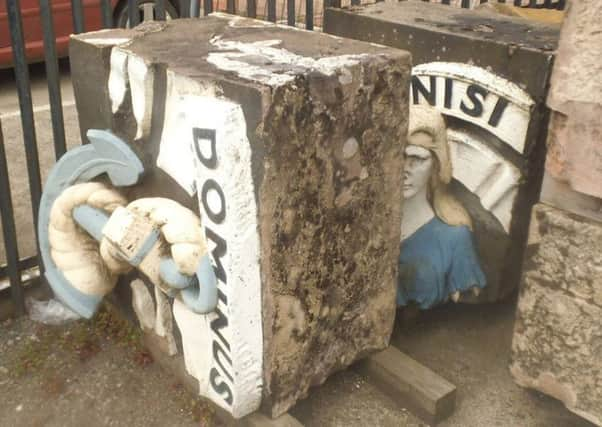Calls to restore city coat of arms torn down from power station


Even better, it warmed the outdoor pool at Portobello and provided the energy to create its waves.
Portobello Power Station’s status as one of the city’s main energy sources was confirmed by the Edinburgh Coat of Arms which held pride of place on the red brick façade.
Advertisement
Hide AdAdvertisement
Hide AdThe building was torn down in 1977 – but now its stone coat of arms has turned up unexpectedly in a council storage centre in Sighthill, broken into pieces.
The discovery has prompted calls for the distinctive stonework coat of arms – featuring a woman, a doe, an anchor and a castle with the motto “Nisi Dominus Frustra” – to be restored and placed close to its original site.
“It seems to be in five pieces which have been clean cut,” said David McLean, whose Lost Edinburgh Facebook page was sent images by a passer-by who spotted them in the yard.
“From looking at the way it’s been cut, it probably wouldn’t take an awful lot to restore it, and it would be really good to see it back together again.
Advertisement
Hide AdAdvertisement
Hide Ad“It’s a piece of Edinburgh’s civic history. Anyone who knows the building would recognises the coat of arms, and it’s a shame they’re not on show.”
Portobello Power Station was a landmark building. It stood just a stone’s throw from the seafront, at the junction of King’s Road and Portobello High Street. Its tall distinctive chimney was visible for miles around for more than 50 years.
The power station was meant to have been built around 1913, but was delayed because of the First World War. The opening of its initial phase in 1923 was such an important occasion that King George V performed the ceremony. One of Britain’s most efficient power stations, it provided electricity to light streets, homes and run the city’s extensive tram network.
It was later extended by Edinburgh’s civic architect Ebenezer MacRae, who replaced the original six chimney stacks with one towering chimney 365ft tall and linked its pipes to his other structure, the nearby Portobello Lido.
Advertisement
Hide AdAdvertisement
Hide AdThousands of Portobello residents and visitors were treated to warm water in the pool and waves powered thanks to the nearby station.
However, the larger, new power stations at Cockenzie – now also demolished – and Longannet, which closed earlier this year, spelled the end of Portobello Power Station and it closed in 1977, with demolition following soon after.
Mr McLean added: “The coat of arms is like a work of art. It was in such a prominent place on such a well known building that it deserves to be seen again.
“Down the years the city’s coat of arms seems to have disappeared. It used to be on the gates and above doors. It was on the front of every child’s school books and everyone knew the motto.”
Advertisement
Hide AdAdvertisement
Hide AdIt’s believed restoring the broken Edinburgh coat of arms could cost around £5000.
A council spokeswoman confirmed the coat of arms had been kept in storage in Penicuik until four years ago, when it was moved to its facility in Murrayburn.
She added: “At present there are no restoration plans. However, if an organisation was to come forward with a funded proposal it could be considered.”
Design dates back to 1732
The city’s coat of arms was formally granted by the Lord Lyon in 1732.
Advertisement
Hide AdAdvertisement
Hide AdIt features a richly dressed woman on the left, a reference to Edinburgh Castle’s historic reputation as a place of safety for princesses. On the right of the shield is a doe, which is a reference to St Giles, the city’s patron saint. The anchor crest represents the Lord Provost’s role as Admiral of the Firth of Forth.
And the shield features a three-turreted black castle with red flags and open drawbridge.
The motto Nisi Dominus Frustra means “Except the Lord in Vain”, and is taken from Psalm 127. Portobello had its own coat of arms. However, it was incorporated into Edinburgh’s in 1896.